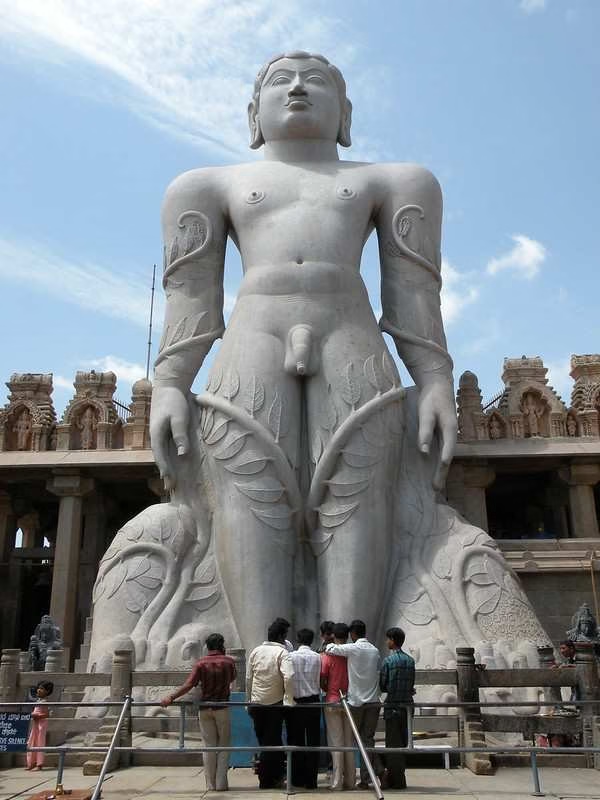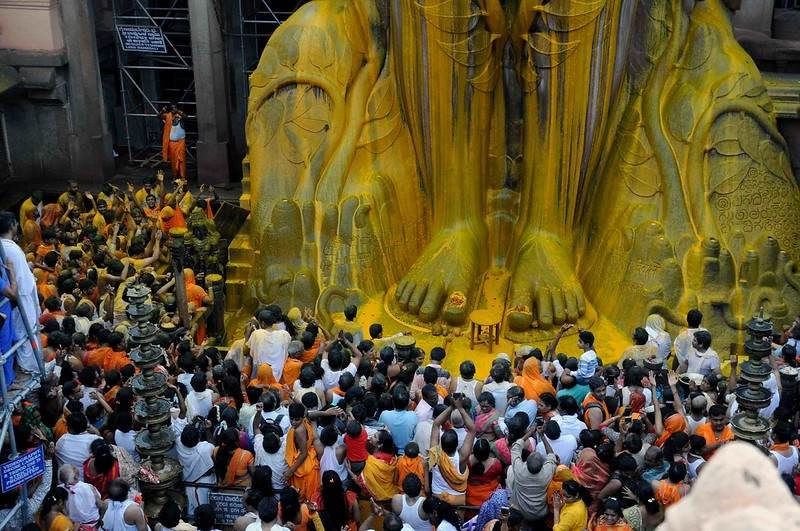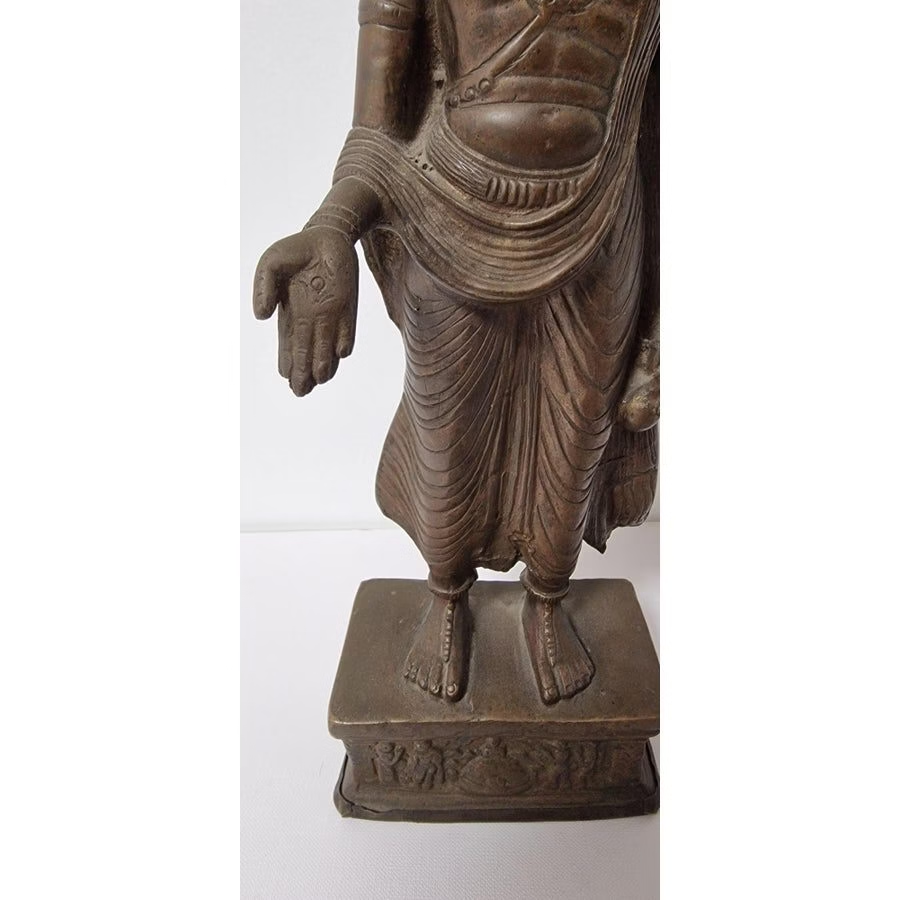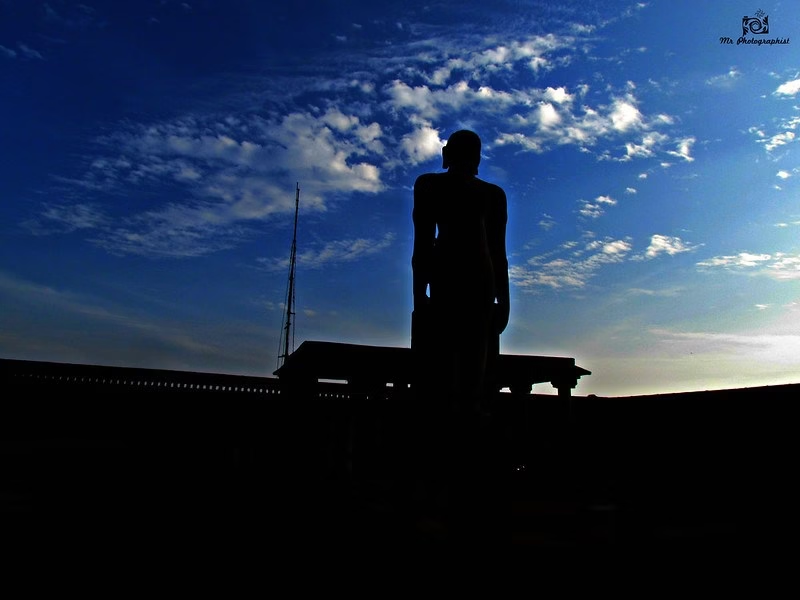Imagine meditating for so long that vines start growing around your body, birds make a nest on your head, and people mistake you for a tree. Sounds extreme? Well, that’s exactly what happened to Bahubali, the legendary figure of Jainism. And if that was not impressive enough, people decided to carve 57-foot-tall statues of him out of a single rock!
Jainism has a knack for creating artistic wonders, and the Gomateshwara statues are the ultimate flex in stonework. These monolithic sculptures, standing as tall as a six-story building, celebrate the ideals of non-violence, renunciation, and deep meditation.
The most famous one, located in Shravanabelagola, Karnataka, is so massive that people conduct elaborate ceremonies just to bathe it. But it’s not alone—several other statues across India continue to amaze visitors and devotees alike.
Now, folks, let’s dive into the world of these magnificent sculptures, uncover their history, and maybe even figure out how ancient sculptors managed to pull off this engineering marvel without modern cranes and coffee-fueled all-nighters.
The Story of Bahubali: The Inspiration Behind Gomateshwara

Every great statue needs an epic backstory, and Bahubali’s story does not disappoint. He was the son of the first Jain Tirthankara, Rishabhanatha, and had a sibling rivalry that makes modern family feuds look tame.
- After their father renounced the throne, Bahubali and his brother Bharata had a disagreement over who should rule.
- Instead of waging war, they decided to settle the dispute through a series of intense competitions (think ancient sibling Olympics).
- Bahubali won but realized that power and wealth were overrated (take notes, billionaires!).
- He renounced everything, stood in deep meditation for a year, and achieved enlightenment—while literally rooted to the spot.
His story symbolizes victory over ego, attachment, and material desires. Jainism honors him as the perfect example of detachment, and what better way to do so than by carving him into rock for all eternity?
Statics on the Statues of Gomateshwara
Height:
- Shravanabelagola: 57 feet (17 meters)
- Karkala: 42 feet (13 meters)
- Venur: 35 feet (10.7 meters)
- Dharmasthala: 35 feet (10.7 meters)
- Gommatagiri: 20 feet (6 meters)
Weight:
- Shravanabelagola: Over 80 tonnes
- Karkala: Over 80 tonnes
Material: Granite
Location: Karnataka, India
Construction Period:
- Shravanabelagola: 981 CE
- Karkala: 1432 CE
- Venur: 1604 CE
- Dharmasthala: 1973 CE
- Gommatagiri: 12th century CE
Festivals: Mahamastakabhisheka (held every 12 years)
Geographic Coordinates:
- Shravanabelagola: 12°51′14″N 76°29′05″E
- Karkala: 13°12′13.6″N 75°00′20″E
Altitude:
- Shravanabelagola: 300 feet (91 meters) above sea level
Number of Statues: 5
Visitors: Attracts devotees from all over the world
Visiting Value:
- Accessibility: Easily accessible by road, with buses available from major cities like Bengaluru and Mysuru.
- Tourism: Significant tourist attractions, especially during the Mahamastakabhisheka festival.
- Accommodation: Dharamshalas (guest houses) are available for visitors.
- Experience: Climbing the steps to the top of Vindhyagiri Hill offers a breathtaking view and a spiritual experience
The Magnificence of the Shravanabelagola Statue

If statues had an award for “Most Jaw-Dropping Monument,” Shravanabelagola’s Gomateshwara would win every time. Towering at 57 feet (17.4 meters) and weighing an estimated 1,000 tons, this sculpture is carved from a single block of granite. It is believed to have been commissioned in 981 AD by the Ganga dynasty’s minister, Chamundaraya, who apparently didn’t believe in small-scale projects.
Some mind-blowing facts about the statue:
- It is one of the largest monolithic statues in the world.
- Carved over 1,000 years ago and still stands strong.
- No visible support or attachment to the base—just pure rock and ancient engineering genius.
- Attracts over 2.5 million visitors every year.
- It is located at an elevation of 470 feet atop Vindhyagiri Hill, making the climb a workout before spiritual enlightenment.
What’s even more fascinating? Despite its age, the detailing is impeccable. The serene expression, elongated earlobes, and perfectly symmetrical features showcase the mastery of ancient Indian sculptors.
Other Gomateshwara Statues in India
While Shravanabelagola’s statue steals the spotlight, it has some impressive siblings. Here are other notable Gomateshwara statues:
Karkala Gomateshwara (Karnataka)
- Stands at 42 feet (12.8 meters).
- It was built in 1432 AD by King Veerapandya of the Bhairarasa Wodeyar dynasty.
- Features a similar meditative stance with intricate stone carvings.
Venur Gomateshwara (Karnataka)
- Stands at 35 feet (10.6 meters).
- Commissioned in 1604 AD by Timmanna Ajila, the Jain ruler of Venur.
- Smaller but equally awe-inspiring.
Dharmasthala Gomateshwara (Karnataka)
- Stands at 39 feet (11.9 meters).
- Installed in 1973, making it the youngest of the lot.
- Located in a town famous for its religious harmony and charitable activities.
What’s impressive is that despite their differences in height and age, all these statues depict Bahubali in his signature meditative pose, symbolizing absolute peace and detachment.
The Rituals and Celebrations: Mahamastakabhisheka

If you think giving your house plants a good watering is a task, wait till you hear about the Mahamastakabhisheka—the grand bathing ceremony of the Gomateshwara statue held once every 12 years. This event is Jainism’s version of a Super Bowl, attracting millions of devotees and tourists.
During the ceremony:
- Priests climb a specially constructed scaffold to pour 1,008 pots of sacred liquids over the statue.
- The statue is bathed in milk, turmeric, sandalwood paste, saffron, honey, and even gold coins (talk about a luxury spa treatment!).
- Devotees chant prayers and seek blessings while watching the massive cleanup unfold.
The last Mahamastakabhisheka in 2018 saw participation from over 3 million people, and the next one is scheduled for 2030. If you plan to witness it, start working on your leg day because the climb to the hill is no joke!
Preservation and Cultural Legacy
With great statutes comes great responsibility. These ancient marvels require constant preservation to combat natural erosion, pollution, and, let’s be honest, overenthusiastic selfie-takers. Conservation efforts include:
- Regular cleaning and coating with protective layers to prevent weather damage.
- Strict regulations against graffiti and vandalism (because nobody wants to see “Rahul was here” on a 1,000-year-old statue).
- Preservation projects supported by UNESCO, the Archaeological Survey of India, and Jain religious organizations.
Beyond preservation, these statues hold immense cultural value:
- They serve as pilgrimage sites for Jains worldwide.
- Scholars study them to understand ancient Indian engineering and sculpture techniques.
- They contribute significantly to religious tourism, generating millions in revenue for local communities.
Art Form and Motifs Combination at Gomateshwara Statues and Their Meanings
If statues could talk, Gomateshwara would probably say, “I have been standing here for over a thousand years, and I still look good!” These monolithic wonders are not just massive blocks of stone; they carry deep symbolic meanings hidden in their artistic details. Every curve, vine, and facial expression has a story to tell.
Ancient sculptors didn’t just chisel out a gigantic meditating man because they were bored. They embedded Jain philosophy, spirituality, and nature’s harmony into these rock-solid masterpieces.
So, let’s break down the motifs and artistic elements that make Gomateshwara statues more than just colossal carvings.
The Meditative Posture (Kayotsarga Mudra) – The Ultimate Zen Mode

- The statue stands in Kayotsarga Mudra, a yogic posture where Bahubali stands tall, motionless, and detached from the physical world.
- This pose symbolizes renunciation, deep meditation, and spiritual liberation—basically, it’s the ancient Jain version of “Do Not Disturb.”
- No crossed legs or fancy yoga twists—just a straight, unwavering posture that screams inner peace and supreme focus.
- The arms hang naturally without any tension, reflecting calmness and balance.
- Unlike other spiritual figures who often hold objects or display hand gestures, Bahubali remains empty-handed. Why? Because he needs nothing. That’s peak minimalism!
The Serene Facial Expression – More Calm Than a Sleeping Monk
- Look at Bahubali’s face. No anger, no excitement, no stress. Just a pure, meditative state.
- The slightly closed eyes reflect inner awareness and detachment—as if he’s tuning out all worldly noise (like a true introvert at a social event).
- The faint smile (or no smile at all) suggests deep contentment, reminding us that real happiness comes from within, not from binge-watching shows or online shopping.
The Creepers and Vines – When Nature Joins the Meditation
- One of the most striking features of the Gomateshwara statues is the creepers winding around the arms and legs.
- These aren’t just for decoration; they symbolize how long Bahubali meditated—so long that nature itself started growing on him.
- The vines creeping up the body show his complete detachment from the world, standing still despite time passing around him.
- It also represents harmony with nature—Jainism teaches non-violence and respect for all living beings, even plants.
The Bare Body – No Fashion, Just Liberation
- Bahubali is depicted completely naked, which might raise a few eyebrows today, but in Jain philosophy, this nudity represents absolute renunciation.
- It signifies freedom from material possessions—no need for clothes, jewelry, or even a loincloth!
- Jain monks often practice the Digambara (“sky-clad”) tradition, where renouncing clothes represents ultimate detachment from ego and desires.
- In short, Bahubali wasn’t about fashion statements; he was about freedom!
The Ant Hills at the Feet – Time Waits for No One
- At the base of many Gomateshwara statues, you will notice ant hills subtly carved into the stone.
- This is yet another sign of his unwavering meditation, where even tiny creatures had enough time to build homes around his feet!
- It represents patience, endurance, and the slow but steady path to enlightenment.
- Also, let’s be honest—standing still for so long without moving is more commitment than most people have for their gym memberships.
The Elongated Earlobes – Wisdom Weighs Heavy
- Bahubali’s earlobes are stretched long, which isn’t because he wore heavy earrings back in the day.
- In Jain and Buddhist iconography, long earlobes symbolize wisdom and spiritual knowledge.
- The idea is that someone who listens deeply to spiritual teachings develops elongated ears—so maybe that’s a sign we should all listen more and argue less!
The Absence of Weapons – Strength Without Violence
- Unlike typical warrior statues that show kings with swords or bows, Bahubali holds…nothing.
- This is because his victory wasn’t through battle but through self-control and inner conquest.
- Jainism preaches Ahimsa (non-violence), and Bahubali embodies this principle perfectly.
- The strongest warrior is not the one who fights but the one who conquers himself. (Take notes, action movie heroes!)
Wrap-up Lines
The Gomateshwara statues are more than just stone-carved giants. They are symbols of peace, meditation, and victory over material desires. Whether you’re a history buff, a spiritual seeker, or just someone who appreciates the marvels of ancient engineering, these monolithic sculptures are worth admiring.
So, the next time you complain about sitting still for a Zoom meeting, think of Bahubali, who stood motionless for a year—without checking his phone once! If he can achieve enlightenment, surely we can survive a few hours of stillness.
And if you ever find yourself in Karnataka, take a moment to stand before these statues, soak in their grandeur, and maybe whisper a quiet thanks to the ancient sculptors who made them possible. Who knows? Maybe a bit of Bahubali’s patience and wisdom will rub off on you!
For further reading, you can visit these useful resources:
Check out our Blog Page on Traditional Indian art.


Leave a Reply